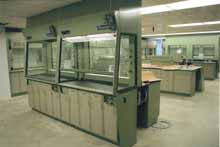 Photos by Stacey Sutton/The Northerner
Photos by Stacey Sutton/The NorthernerPhysics professor Dr. Wayne Bresser’s days of conducting experiments in a cramped space in the old science building with outdated equipment are numbered. Next semester, Northern Kentucky University will open up the $38 million technologically-savvy science building, which will give Bresser and other professors who conduct research the space and equipment needed. Bresser experiments on the properties of glass and said he currently operates in a room that cannot fit all the equipment he needs. For some of his tests, Bresser said he must make a trek up to the University of Cincinnati.
Bresser said the building will put NKU on the map, making it easier for him and other professors doing research to get funding from the National Science Foundation. Bresser said the impending opportunity to try out the new features of the state-of-the-art complex excites him. “This is just like a brand new home,” Bresser said. “It is so neat and exciting to explore different areas.”
The new building will have two labs that can be used for student and private research. Undergraduates will be able to collaborate with professors on research projects, which director of campus planning Mary Paula Schuh said sets NKU apart from other universities. Most other universities reserve this privilege for graduate students.
“It is the best kept secret that undergraduate students can work elbow to elbow with faculty,” Schuh said.
The science building will also feature classrooms that give multiple students access to computers and the Internet. In addition, classrooms and labs will be more closely connected. There are 14 labs and 9 lecture halls in the new building, which means many lectures will be held in the labs as well. The Physics department is taking advantage of this by combining lecture and lab courses together. Biology and Chemistry will do this for some, while still keeping others separate. This will give classes a more flexible structure, allowing the lab to blend with the lecture, said Dr. Charles Hawkins, chair of the physics, astronomy and geology department. The labs themselves will be able to seat more students, increasing the capacity from the 16 students to 24 students. Hawkins said he is also looking forward to working in labs that weren’t designed in the 1960s. The labs in the old science building were modeled in an outdated fashion where all the workstations are immobile and rigid, Hawkins said.
An upgrade in the labs on campus was sorely needed to ensure the safety of the students, said Dr. Bill Oliver, chair of the chemistry department. Both Hawkins and Oliver cited among the faults of the old labs a lack of ventilation, humidity control and outdated electrical equipment and inadequate hoods for containing hazardous chemicals.
“Obviously when you walked around the old science building, you could smell some experiments going on and that isn’t good,” Oliver said.
The new science building will have some labs with individual hoods for each student. The new science building isn’t flawless, however. All three departments do not gain classrooms from the move and office space does not increase, a concern all three departments said may pose an obstacle for future expansion. By the time the ribbon is cut for the building, all offices will be occupied by faculty and staff. In addition, the geology department will be losing two lecture rooms, rather than gaining more rooms. The chairs of the science department said they aren’t sure how they will tackle the space situation. “It is hard to say since we are talking about facilities we haven’t used yet,” Hawkins said. “Office space will be pressed. That is a great concern.”
Hawkins said the science department repeatedly pointed out the space situation, but Schuh said the funding wasn’t there for more office space. They had to cut back four offices that were originally in the design, she said.
“Had money not been an issue, there would have been more offices,” Schuh said.
While office space will be tight, Omni architects, the designers of the building, strategically placed the offices throughout the building in relation to the classrooms. The designers placed the chairs of each department right next to each other on the second floor. The university hopes this will encourage the departments to collaborate in future projects, Schuh said, and work more closely with each other.
“They need synergy,” Schuh said. “It will foster communication. The sciences tend to be cloistered. This will provide more of an environment for doing cooperative research.”
The classes and the rest of the building’s 55 offices will be situated according to function, said Omni project manager Eric Zabilka, AIA. The offices of teachers will be next to the classes they teach rather than grouped departmentally like they are now. Designing a large building to house updated technology wasn’t easy, Zabilka said. The design of the building began in 1998, and he said computers have changed considerably since then.
“Expectations on technology keep changing,” Zabilka said. “We had to keep playing catch-up.”
The idea of designing a state-of-the-art building with a design focused on co-operative working was challenging, Zabilka said.
“We were incredibly excited,” Zabilka said. “NKU has set up something ahead of the curve.”

